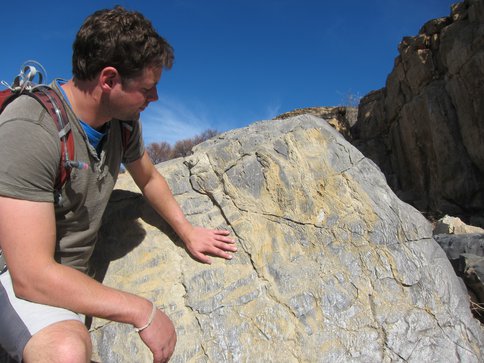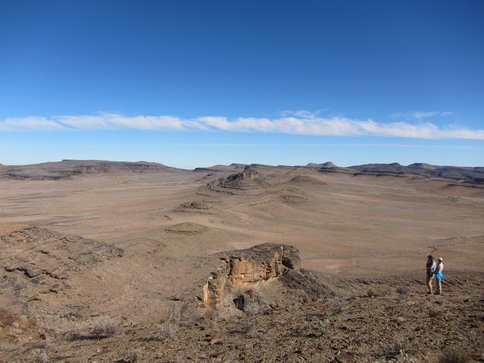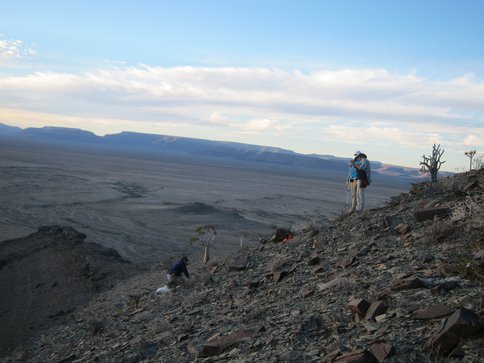2013 Annual Science Report
 Massachusetts Institute of Technology
Reporting | SEP 2012 – AUG 2013
Massachusetts Institute of Technology
Reporting | SEP 2012 – AUG 2013
Early Animals: The Origins of Biological Complexity
Project Summary
The fossil record provides the best evidence for the emergence of complex life and its relationship to changes in the environment. But this record is increasing supplemented by comparative studies of the development of living animals. Our group has been working on both the fossil record of some of the oldest fossil evidence of animals, as well as applying studies of the development of modern animals to interpret these fossils. The goal is to understand the interactions between changes in the physical environment, ecological interactions and in developmental mechanisms in evolutionary innovations leading to greater biological complexity.
Project Progress
In January 2013, The Cambrian Explosion: The Construction of Animal Biodiversity by Douglas Erwin and Jim Valentine was published (Roberts Publishing); a second printing was published in December. Written over the past four years, this is the first integrated account of the nature and likely causes of the origin and early diversification of animals. The book argues that these events can only be understood through integration of our understanding of changes in the physical environment, principally changes in ocean redox, in the construction of networks of ecological interactions, and in the growth of regulatory interactions in gene networks that control development. The book was reviewed in Science, Current Biology, and elsewhere. Our group is now expanding the approach developed in this book to look at other major evolutionary transitions earlier in the history of life. With a number of colleagues, Erwin also completed some earlier projects examining the late Permian mass extinctions, demonstrating that the late-Guadalupian marine mass extinction may not have affected terrestrial vertebrates in South Africa, and providing further detail on the rapidity of the end-Permian extinction.
Graduate Student Sarah Tweedt (University of Maryland, but working at NMNH) defended her thesis proposal and passed her preliminary examination in early 2013. She is now working on a suite of three projects examining the developmental morphospace of the Ediacaran and early panarthropods using a new approach to defining morphospace. Post-doctoral fellow Marc Laflamme continued his studies of the preservation and systematics of Ediacaran forms. We published the first detailed analysis of discussions of the transition between the organisms of the Ediacaran and those of the earliest Cambrian, evaluating proposals for a mass extinction at the end of the Ediacaran versus other alternatives associated with a more gradual transition or preservational bias.
We also began what we expect to be a series of field campaigns to find and study new Ediacaran-age localities in southern Namibia (Figures 1-3).This area was studied with during the 1990s and early 2000s by John Grotzinger and his colleagues but there remain a number of areas that have yet to be thoroughly explored for fossils. Our initial two-week field season in 2013 identified several promising new areas that we will explore in greater depth in May 2014. In addition we discovered new material at several previously studied localities.
Publications
-
Darroch, S. A. F., Laflamme, M., & Clapham, M. E. (2013). Population structure of the oldest known macroscopic communities from Mistaken Point, Newfoundland. Paleobiology, 39(4), 591–608. doi:10.1666/12051
-
Darroch, S. A. F., Laflamme, M., Schiffbauer, J. D., & Briggs, D. E. G. (2012). EXPERIMENTAL FORMATION OF A MICROBIAL DEATH MASK. PALAIOS, 27(5), 293–303. doi:10.2110/palo.2011.p11-059r
-
Narbonne, G. M., Laflamme, M., Trusler, P. W., Dalrymple, R. W., & Greentree, C. (2014). Deep-Water Ediacaran Fossils from Northwestern Canada: Taphonomy, Ecology, and Evolution. Journal of Paleontology, 88(2), 207–223. doi:10.1666/13-053
-
Odling-Smee, J., Erwin, D. H., Palkovacs, E. P., Feldman, M. W., & Laland, K. N. (2013). Niche Construction Theory: A Practical Guide for Ecologists. The Quarterly Review of Biology, 88(1), 3–28. doi:10.1086/669266
-
Pruss, S. B., Clemente, H., & Laflamme, M. (2012). Early (Series 2) Cambrian archaeocyathan reefs of southern Labrador as a locus for skeletal carbonate production. Lethaia, 45(3), 401–410. doi:10.1111/j.1502-3931.2011.00299.x
-
Rubidge, B. S., Erwin, D. H., Ramezani, J., Bowring, S. A., & De Klerk, W. J. (2013). High-precision temporal calibration of Late Permian vertebrate biostratigraphy: U-Pb zircon constraints from the Karoo Supergroup, South Africa. Geology, 41(3), 363–366. doi:10.1130/g33622.1
-
Schiffbauer, J. D., & Laflamme, M. (2012). LAGERSTATTEN THROUGH TIME: A COLLECTION OF EXCEPTIONAL PRESERVATIONAL PATHWAYS FROM THE TERMINAL NEOPROTEROZOIC THROUGH TODAY. PALAIOS, 27(5), 275–278. doi:10.2110/palo.2012.so3
-
Wang, Y., Sadler, P. M., Shen, S-Z., Erwin, D. H., Zhang, Y-C., Wang, X-D., … Henderson, C. M. (2014). Quantifying the process and abruptness of the end-Permian mass extinction. Paleobiology, 40(1), 113–129. doi:10.1666/13022
- Erwin, D.H. & Valentine, J.W. (2013). The Cambrian Explosion: The Construction of Animal Biodivisity. Ben Roberts Publishing.
- Erwin, D.H.T. (2013). Oxford Bibliographies in Evolutionary Biology [Online].
- Erwin, D.H.T. (In Press). Wonderful Life revisited: Chance and contingency in the Ediacaran-Cambrian explosion. In: Pence, G.R.a.C.H. (Eds.). Chance in Evolution. University of Chicago Press.
- Tweedt, S.M. & Erwin, D.H. (Submitted). Origin of Metazoan developmental toolkits and their expression in the fossil record. In: Ruiz-Trillo, I. & A., N. (Eds.). Evolution of Multicellularity.
-
PROJECT INVESTIGATORS:
-
PROJECT MEMBERS:
Douglas Erwin
Co-Investigator
Marc LaFlamme
Collaborator
Sarah Tweedt
Collaborator
-
RELATED OBJECTIVES:
Objective 4.1
Earth's early biosphere.
Objective 4.2
Production of complex life.
Objective 4.3
Effects of extraterrestrial events upon the biosphere


